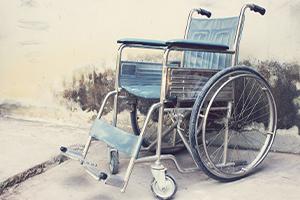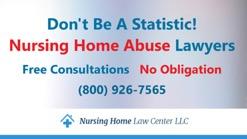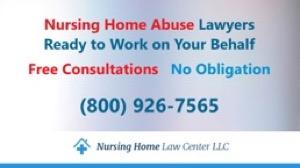The Nursing Home Law Center is committed to providing the legal resources necessary to hold negligent facilities accountable.
Nursing Home Abuse Statistics

Elder abuse happens when a caregiver, family member, or other trusted person causes harm to an elderly person, either through mistreatment or negligence. It can occur in a person’s home, a retirement community, or a nursing home.
In this article, we will cover nursing home abuse statistics, the types of elder abuse, risk factors, consequences, and ways to address the issue.
Statistics of Elder Abuse
The prevalence of elder abuse is a growing concern worldwide, particularly in institutional settings like nursing homes. According to the World Health Organization, one in six older adults has experienced some type of abuse globally. In the U.S., the percentage stands at about 10%. [1] During the pandemic, this doubled to 1 in 5 older adults. [2]
Perpetrators of abuse and neglect can be family members, nursing home staff members, nursing home visitors, and other residents in nursing homes, with strangers making up the lowest percentage of abusers.
- Family members – According to the National Council on Aging (NCOA), approximately 60% of elder abuse cases involve a family member as the abuser. This includes spouses, adult children, and grandchildren. [3]
- Nursing home staff and caregivers – Two-thirds of nursing home staff admitted to perpetrating some form of abuse or neglect. [4]
- Institutional abuse – Nursing home administrators and management can contribute to the abuse through understaffing, failing to report abuse, and policies that put profit over resident safety. In 2024, 46% of nursing homes have had to turn away new residents due to labor shortages. [5]
- Strangers or scammers – The FBI reported that older adults lost $3.4 billion in 2023 due to financial fraud, 11% more than the previous year.[6]
Long-term care facilities have an exceptionally high rate of abuse. According to the National Center for Elder Abuse (NCEA), 44% of nursing home residents have been abused, while 95% of residents experienced neglect or saw it happening to another resident. [7]

Underreporting of Abuse
Nursing home abuse statistics do not encompass the scale of the problem, as only 1 in 24 cases get reported. [8]
According to the Department of Justice [9], this report-per-act ratio varies depending on the type of abuse:
- Caregiver neglect (1:57)
- Financial exploitation (1:44)
- Physical abuse (1:20)
- Psychological abuse (1:12)
The reasons behind underreporting are diverse. They can include:
- Fear of retaliation
- Cognitive impairment
- Lack of awareness
- Social isolation
- Dependence on the abuser
- Staff shortages and institutional barriers
Types of Abuse in Nursing Homes
Elder abuse can take many forms. The NCOA shows the most common form of elder abuse in nursing homes is physical abuse (29%), followed by resident-to-resident abuse (22%), gross neglect (14%), financial abuse (7%), and sexual abuse (7%). This section will look at the numbers, uncovering more about each type.
Physical Abuse
According to the National Ombudsman Reporting System data for 2023, there were 9,695 abuse complaints in all settings, including nursing homes and residential care communities. [19] Out of this number:
- 4,334 stated a staff member was the perpetrator
- 4,581 stated it was another nursing home resident
- 244 stated it was a family member, friend
- 588 stated it was someone else
Physical nursing home abuse can include hitting, slapping, pushing, and the inappropriate use of physical restraints.
In a JAMA study, 7.4% of residents have been involved in physical violence with another resident during one year. [11]
When it comes to abuse perpetrated by staff, a survey showed that 24.3% of respondents with family members in nursing homes or assisted living facilities reported at least one such incident. [12]
In North America, 22% of residents have been physically restrained, although data doesn’t show it decreases falls or fall-related injuries. [13]
Emotional Abuse
Psychological abuse of nursing home residents includes verbal abuse, humiliation, intimidation, and isolation. In 2023, there were 4,360 emotional abuse complaints.
- In 3,133 cases, the care facility or staff were responsible for the abuse.
- In 780, it was another resident.
- In 300, the perpetrator was a friend, family member, or resident representative.
- In 230, it was someone else. [19]
Neglect
Neglect happens when healthcare providers fail to ensure appropriate medical treatment and meet basic needs like water, food, and personal hygiene. This also includes situations where elderly patients live in unsafe and unsanitary conditions.
Neglect can lead to:
Gross neglect of elderly patients was reported 5,024 times in 2023, and it has been overwhelmingly perpetrated by long-term care facilities, with 4,253 reports. Gross neglect can also include medication errors, such as not giving patients medication.
Sexual Abuse
Sexual abuse is less frequently reported due to social stigma, fear of retaliation, and situations when the survivor has dementia, Alzheimer’s disease, or another form of cognitive impairment.
In 2023, there were 1,862 sexual abuse reports, and only 130 of them were referred to law enforcement.
- In 814 complaints, the perpetrator was a staff member.
- In 715 complaints, other residents were the perpetrator.
- In 48 cases, it was a friend, family member, or resident rep.
- In 306, the perpetrator belongs to some other category. [19]
Financial Exploitation
Financial abuse and exploitation include theft, fraud, misuse of funds, and undue influence. Per the last report, 3,199 complaints were filed. The perpetrators were:
- Facility employees in 719 cases
- Another resident in 57 cases
- A family member, friend, or resident representative in an overwhelming 1,823 cases
- Someone else, in 645 cases [19]

Risk Factors for Nursing Home Abuse
Risk factors for abuse and neglect include resident and perpetrator characteristics, staffing issues, and facility characteristics.
Resident Characteristics
Older adults with specific characteristics are more likely to suffer abuse due to the vulnerability that the perpetrators exploit. This includes:
- Cognitive issues – Dementia, Alzheimer’s, or severe mental illness may make it difficult for patients to understand, remember, or articulate instances of abuse. Patients with mental health issues may be easier to take advantage of. According to the National Council on Aging, more than half of people with dementia experienced abuse or neglect.
- Physical limitations – Limited mobility, arthritis, or chronic illness make residents more reliant on nursing aides for daily needs, from hygiene to feeding. They also make them more likely to receive inadequate care.
- Dependence on others – Residents dependent on a nursing aide may fear losing assistance if they report mistreatment. Residents needing personal care help are also more likely to be near staff members.
Staffing Issues
Institutional factors like understaffing, high staff turnover, inadequate training, and low wages significantly increase the risk of elder abuse. These systemic issues in lower quality facilities create environments where abuse can occur more readily, often stemming from strained resources, poor staff morale, and a lack of oversight.
Elder abuse statistics show the following about each factor:
- Understaffing – The National Consumer Voice for Quality Long-Term Care reports that over 90% of U.S. nursing homes are understaffed. This leads to rushing the care, neglect, increased stress, and burnout, all of which are risk factors for abuse and neglect. [14]
- Turnover rates – Abuse and neglect rates rise with staff turnover. Nursing homes with a turnover rate between 60% and 69% have double the number of abuse citations compared to 30% to 39%. [14]
- Training – Inadequate training may lead to neglect, abuse, and the unnecessary use of restraints.
- Low wages – Low wages may make healthcare providers more likely to suffer burnout, stress, and overall lower quality of life, which often impacts elderly residents.
Facility Characteristics
Poor management, inadequate oversight, and a history of violations can increase the likelihood of abuse in certain nursing facilities.
Another risk factor is the organization type. According to the National Center on Elder Abuse, for-profit nursing facilities are less likely to provide high-quality care than non-profit facilities. [15] Prioritizing profit can lead to understaffing and cutting costs on other essential services.
Consequences of Nursing Home Abuse
The consequences of nursing home abuse in care facilities can be dire, harming the residents’ physical and mental health, increasing the risk of premature death, and creating financial issues.
Physical and Psychological Harm
Abuse and neglect can have a severe impact on the victim’s mental health, creating emotional trauma and affecting their cognitive function. Feelings of shame, isolation, anxiety, and depression are common among survivors.
Physical consequences can include anything from physical injuries such as fractures to poor physical health, infections, disability, and death. Older adults, especially those with weaker bones and frail health, are particularly vulnerable, and a minor incident can lead to serious complications.
Increased Mortality Risk
Nursing home abuse statistics show that less severe abuse also increases the mortality and morbidity rate in the elderly population by 300%. [16] The reason behind this is the combined impact of physical and psychological stress on overall health.
According to a report in Healthcare Policy, which compared pandemic and pre-pandemic mortality rates, neglect played a significant role:
- Before 2020, people who showed signs of neglect had a 55% higher chance of dying within 90 days of assessment.
- During the pandemic, this increased to 80% more than residents who did not show signs of neglect. [17]
Financial Burden
Addressing the consequences of abuse, such as injuries and psychological health issues, poses a financial burden on the resident and their family.
Elderly people who have experienced abuse have higher medical care costs in the 12 months following the abuse incident discovery. [18] According to this study, the victims had $5,084 in additional total healthcare costs and $5,817 in total additional costs afterward.
This can erode the personal savings of families and abused residents, adding significant distress to an already difficult situation.
Addressing the Problem of Nursing Home Abuse
The issue of elder mistreatment in nursing homes has high personal, emotional, and financial costs, affecting not just the resident and their family but the entire society. It is also underreported, and with the rising workforce shortage, it threatens to become worse.
That’s why addressing the issue is critical for policymakers, healthcare providers, families, facilities, and legal professionals.
Raising Awareness and Education
Raising awareness about elder abuse is vital to keeping nursing home residents safe. When staff, families, and residents know the signs, they are more likely to report elder abuse to facility management, law enforcement, and Adult Protective Services.
The signs include:
- Unexplained injuries
- Sudden emotional changes
- Poor hygiene
- Malnutrition
It’s equally important to understand the signs on the side of the perpetrator:
- Stress and burnout
- Poor mental health
- Substance abuse
- Overly controlling behavior
- Isolation of residents
- Dismissive attitude
Strengthening Regulations and Oversight
To ensure nursing homes are held accountable for preventing abuse, we need stricter criminal and civil laws, more frequent inspections, and better enforcement.
This includes more common, unannounced inspections and strong oversight that will empower staff, residents, and their families to report suspected abuse to administration or law enforcement officers without fear of retaliation.
Finally, more substantial penalties for perpetrators of abuse in nursing home settings may act as a deterrent to other facilities and staff members.
Supporting Victims and Families
Dealing with abuse can be overwhelming, both emotionally and financially, so access to legal assistance and advocacy is vital. Families need guidance on navigating the legal system, understanding their rights, and ensuring the abusive parties are held accountable.
By offering these resources, we empower victims and their families to rebuild their lives, find justice, and ensure the abuse doesn’t continue.
Contact a Nursing Home Abuse Lawyer for Legal Assistance
Nursing Home Law Center is dedicated to helping families and residents overcome the consequences of abuse. We provide survivors with legal help, ensuring they can recover compensation for their physical, financial, and emotional harm.
We have helped families recover millions and hold facilities accountable for their negligence. Call (800) 926-7565 for a free consultation with a nursing home abuse lawyer.
References: [1] World Health Organization, [2] National Library of Medicine,[3] National Council on Aging,[4] World Health Organization,[5] American Health Care Association,[6] Federal Bureau of Investigation,[7] National Library of Medicine,[8] National Council on Aging, [9] Department of Justice,[10] National Ombudsman Reporting System, [11] JAMA Network, [12] National Library of Medicine, [13] National Library of Medicine, [14] Consumer Voice, [15] National Center on Elder Abuse, [16] Office for Victims of Crime, [17] National Library of Medicine, [18] National Library of Medicine, [19] Consumer Voice

